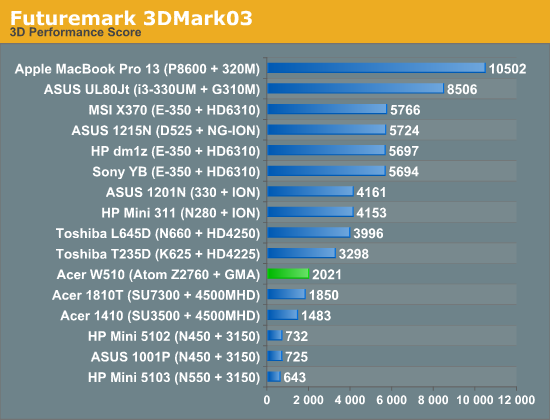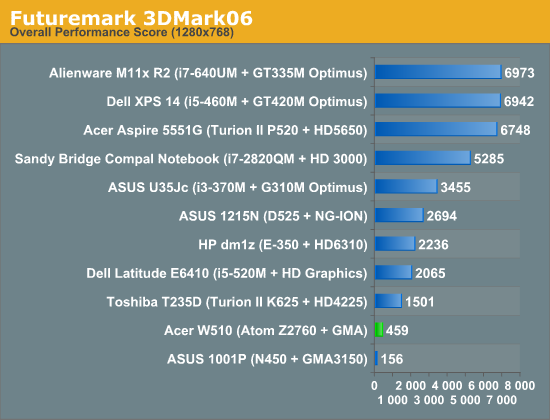The Clover Trail (Atom Z2760) Review: Acer's W510 Tested
by Anand Lal Shimpi on December 20, 2012 10:34 AM ESTGPU Performance
Contrary to popular opinion prior to its launch, the Clover Trail platform and Cloverview SoC feature a PowerVR SGX 545 GPU. The rumored PowerVR SGX 544MP2 won’t show up until Clover Trail+ next year. The SGX 545 is clocked at a fairly aggressive 533MHz.
Architecturally the 545 is very similar to the PowerVR SGX 540 used in Intel’s Medfield smartphone platform, with a handful of additions. The shader array remains unchanged at four USSE pipes. The 545 adds four more 10-bit integer pipes, doubles the triangle setup rate and doubles the number of depth test units as well. DirectX 10 class texture hardware is also a part of the mix, as well as everything else needed to officially support DirectX 10 (D3D feature level 9_3).
Compared to what’s shipping in the latest iPads however, Clover Trail is horribly under-specced. We don’t have good cross-platform (Windows RT/8) GPU tests yet, but based on what I’ve seen thus far it looks like the GPU here is a bit slower than what you get in a Tegra 3.
| Mobile SoC GPU Comparison | |||||||||||
| PowerVR SGX 545 | NVIDIA Tegra 3 | PowerVR SGX 543MP2 | PowerVR SGX 543MP4 | PowerVR SGX 554MP4 | |||||||
| Used In | Clover Trail | Tegra 3 | iPad 2/mini | iPad 3 | iPad 4 | ||||||
| SIMD Name | USSE | "core" | USSE2 | USSE2 | USSE2 | ||||||
| # of SIMDs | 4 | 12 | 8 | 16 | 32 | ||||||
| MADs per SIMD | 2 | 1 | 4 | 4 | 4 | ||||||
| Total MADs | 8 | 12 | 32 | 64 | 128 | ||||||
| GFLOPS @ 300MHz | 4.8 GFLOPS | 7.2 GFLOPS | 19.2 GFLOPS | 38.4 GFLOPS | 76.8 GFLOPS | ||||||
Looking at raw FP performance tells us a lot of the story. The 545’s high clock helps it punch above its weight, but it's still significantly less powerful than the 543MP2 used in the iPad 2/mini (and it’s nothing compared to what’s in the iPad 3/4).
Tegra 3-class GPU performance may have been acceptable a year ago running Android, but it’s just too little too late today. Since Clover Trail has full backwards compatibility with older Windows applications, I can put its GPU performance in perspective. Turning to 3DMark03 and 06, we can get a good idea of the class of performance we’re looking at. For complete (and consistent) comparison points, I've tossed the W510's results into Bench so you can compare to any notebook/mobile GPU you want to there.


Compared to the old Atom platform with Intel’s GMA 3150, the PowerVR SGX 545 based GMA is around 3x faster. Even Intel's old mobile G45 graphics are actually slightly slower. Performance is still far behind everything else modern though. The GPU is more than adequate for Modern UI acceleration, but if you have secret hopes of being able to run some of your older games on Clover Trail you’ll want to stash those dreams away.
None of this is really Imagination’s fault - Intel remains generations behind in implementing competitive GPUs in its ultra mobile SoCs. Even the jump to PowerVR SGX 544MP2 next year will happen just as Apple likely moves to Img’s Series 6 (Rogue) architecture. It’s definitely a problem if you’re a silicon company that delivers slower silicon than what your customers can put together.










104 Comments
View All Comments
londiste - Friday, December 21, 2012 - link
are the windows x86 drivers for powervr sgx now stable and feature complete? the first batch of reviews for atoms containing these, including the one in anand iirc, complained a lot about the stability of video drivers.the fact that these crashes are system-wide, would rule out specific applications, but not drivers.
windows 8 by itself, especially on x86 (but maybe even more so for the rt on arm) has been very stable.
MFK - Thursday, December 20, 2012 - link
Can we get a detailed write up of how eMMC differs from SATA?I'd be very interested in reading Anandtechs analysis on the differences between them.
It just seems to be the very prevalent now with smartphones and Atom tablets both using it.
DanNeely - Thursday, December 20, 2012 - link
MMC is a memory card standard similar to the more common SD; eMMC is just an embedded version. Outside of the embedded world MMC is mostly used to increase the number of supported formats claimed by card readers.tempestglen - Thursday, December 20, 2012 - link
http://www.anandtech.com/show/6330/the-iphone-5-re...I am very curious about the Z2760 electricity consumption when running kraken.
Anand Lal Shimpi - Thursday, December 20, 2012 - link
Working on something even cooler, give me a few days... :)Take care,
Anand
tempestglen - Friday, December 21, 2012 - link
Great! Hope you use a test application which could utilities all of the CPU cores. Kraken is good but not perfect, could Kraken make 100% usage on dual core?DanNeely - Thursday, December 20, 2012 - link
Could you add dimensions for the combined tablet + dock?mayankleoboy1 - Thursday, December 20, 2012 - link
Clover Trail is a failure. It is competitive with Tegra3. Great.But tegra3 itself is outdated now. Anyone notice that no new top-line smartphone has tegra3. All have Krait4. And will soon have Exynos5.
If all Intel has to show for its efforts is competition with tegra3/A9 , its in some deep shit.
The GPU is particulerly shitty. Either Intel need a node shift to 14nm, or a new arch or both.
jhoff80 - Thursday, December 20, 2012 - link
Maybe I'm being naive, but it sounds like Bay Trail will be exactly that new architecture for Atom that Intel needs.jeffkibuule - Thursday, December 20, 2012 - link
Clover Trail is just a stop gap. It's using a 5 year old architecture with a GPU that even the iPad 2 from 2 years ago could outperform. I think it's purposefully designed to be cheap.I'd be far more interested to see what Bay Trail (next-generation Atom) and Haswell (next-generation Core) bring to the table, because at least it will look like Intel is trying.